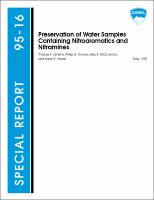Please use this identifier to cite or link to this item:
https://hdl.handle.net/11681/12102| Title: | Preservation of water samples containing nitroaromatics and nitramines |
| Authors: | Environmental Laboratory (U.S.) U.S. Army Environmental Center Jenkins, Thomas F. Thorne, Philip G. McCormick, Erika F. Myers, Karen F. |
| Keywords: | Acidification Explosives RDX Water Analysis Preservation TNT Nitroamines Nitroaromatic compounds |
| Publisher: | Cold Regions Research and Engineering Laboratory (U.S.) Engineer Research and Development Center (U.S.) |
| Series/Report no.: | Special report (Cold Regions Research and Engineering Laboratory (U.S.)) ; 95-16. |
| Description: | Special Report Abstract: This study was conducted to develop a method for stabilizing water samples to be analyzed for nitroaromatic and nitramine explosives using SW846 Method 8330. Several options were tested using river water fortified with 15 nitroaromatic, nitramine, and aminonitroaromatic analytes. Acidification to pH 2 using sodium bisulfate was selected based on its ability to retard microbiological and chemical transformations, its ease of use under field conditions, and its usability with both the direct and preconcentration procedures in Method 8330. Holding-time studies were performed over a 64-day storage period using fortified river water and groundwaters with and without chemical stabilization. Nonacidified samples showed rapid loss of tetryl, TNB, and TNT and slower loss of the dinitroaromatics. These losses were accompanied by increasing concentrations of transformation products. Losses of these nitroaromatics were completely eliminated by acidification to pH 2. Nitramines were stable over the entire period whether samples were acidified or not. A small loss of the aminodinitroaromatics was observed for both acidified and unacidified samples. The rate of loss for acidified samples was initially greater than for nonacidified samples. Sample acidification caused no adverse effects on SW846 Method 8330, although samples to be preconcentrated using salting-out solvent extraction should be neutralized prior to extraction to prevent additional loss of aminodinitroaromatics. |
| Rights: | Approved for public release; distribution is unlimited. |
| URI: | http://hdl.handle.net/11681/12102 |
| Appears in Collections: | Special Report |
Files in This Item:
| File | Description | Size | Format | |
|---|---|---|---|---|
| SR-95-16.pdf | 544.25 kB | Adobe PDF |  View/Open |